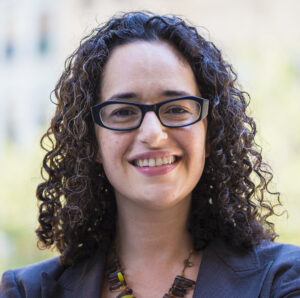
The Terrifying Third Aliyah of Behukkotai
May 31, 2024 By Marcus Mordecai Schwartz | Commentary | Behukkotai | Shavuot
Why do we continue to read such horrible curses, and another passage much like it in Parashat Ki Tavo (Deut. 28:1–68), each year? The simplest answer is that we read the entirety of the Torah each year, omitting nothing. However, the Mishnah (Megillah 3:6) already notes something special about the curses of the Leviticus passage: “The section of curses must not be broken up but must all be read by one person.”
Read More
What Can a Bird and a Seed Teach Us About Shemitah?
May 24, 2024 By Yael Hammerman | Commentary | Behar
In Parashat Behar, God tells the Israelites that when they enter the land that God will give them, “the Land shall observe a Sabbath of the Adonai”—veshavta ha’aretz Shabbat l’Adonai (Lev. 25:2). This becomes known as the shemitah year. For six years, you can work to your heart’s content—you can sow, prune, and gather, but in the seventh year, the land shall have a full, complete rest: shabbat shabbaton yihiyeh la’aretz (Lev. 25:4)!
Read More
Are We Just Speaking, or Truly Communicating?
May 17, 2024 By Loraine Enlow | Commentary | Emor
Perhaps the breaking of the formula for our parashah’s irregular emor is about more than just words. Using its characteristic wordplay, the Midrash connects the parashah’s emor here to omer in Psalm 19:3 (spelled the same way, but as a poetic noun): “day to day utters speech (omer), and night to night reveals knowledge.” It explains that the day and the night are negotiating the giving and borrowing of time from each other to create the cycles of the year between the equinoxes. Reading the next verse in the psalm, we see “there is no speech (omer) . . .” Or as the Midrash puts it, “they pay each other back harmoniously, without a contract.”
Read More
What Do the Dead Know?
May 3, 2024 By Jonathan Boyarin | Commentary | Aharei Mot
This week’s Torah portion begins with the words “after the death,” referring to the death of Aaron’s sons Nadab and Abihu. I appreciate the chance to contribute this week’s commentary, since I’m currently teaching a course titled “Death, Dying, and the Dead” at JTS. Much of the course is about Jewish death rituals, but I also aim to convince my students that Jewishness per se is inconceivable without some notion of the continuing presence of the dead in the world of the living. The tradition for the most part seems to take this continued presence for granted, though questions arose about exactly how it manifests.
Read More
In Each and Every Generation
Apr 19, 2024 By Burton L. Visotzky | Commentary | Pesah
Twice in the Passover liturgy we hear the phrase, “in each and every generation.” We are taught that “in each and every generation a person is obligated to see himself as though he had participated in the Exodus from Egypt.” On the other hand, we are reminded that “in each and every generation they arise against us to destroy us.” The consolation is that The Holy, blessed be God, presumably saves us from their hands.
Read More
Charting a Way Back
Apr 12, 2024 By Ayelet Cohen | Commentary | Tazria
The book of Vayikra can be understood as an exercise in transition; if one imagines the Torah as the lifecycle trajectory of Israel, this The book of Vayikra can be understood as an exercise in transition; if one imagines the Torah as the lifecycle trajectory of Israel, this book represents adolescence/early adulthood. The Israelites are still transitioning from being an enslaved people toward becoming a free people. With their newfound autonomy, they must learn responsibility to one another and service to God. They struggle with faith, patience, ethical behavior, interpersonal relationships, and boundaries—in short, all of the things that are hard about maturation and adulthood. book represents adolescence/early adulthood. The Israelites are still transitioning from being an enslaved people toward becoming a free people. With their newfound autonomy, they must learn responsibility to one another and service to God. They struggle with faith, patience, ethical behavior, interpersonal relationships, and boundaries—in short, all of the things that are hard about maturation and adulthood.
Read More
Honoring Aaron’s Tragic Sacrifice in the Laws of Mourning
Apr 5, 2024 By Shira Billet | Commentary | Shabbat Hahodesh | Shemini
Shemini begins on the eighth and final day of inauguration week. The ceremony narrated in Leviticus 9 culminates in a felicitous and ecstatic moment of response from God to their carefully orchestrated sacrificial rites: “Moses and Aaron then went inside the Tent of Meeting. When they came out, they blessed the people; and the Presence of the Lord appeared to all the people. Fire came forth from before the Lord and consumed the burnt-offering . . . on the altar. And all the people saw, and shouted and fell on their faces” (Lev. 9:23-24).
Read More
Prayer as Resonance
Mar 29, 2024 By Luciana Pajecki Lederman | Commentary | Shabbat Parah | Tzav
According to sociologist Harmut Rosa, the main role of rituals is to produce axes of resonance, through which we not only affect but also open ourselves to being affected by God, people, and even things around us. In conceiving of Jewish prayer, our ancient rabbis indicate a concern with creating resonance, by balancing “affecting” and “being affected.”
Read More


